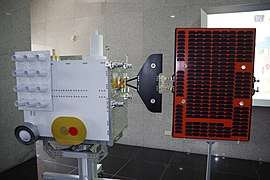COSMIC-2
COSMIC-2 also known as FORMOSAT-7, is the constellation of satellites for meteorology, ionosphere, climatology, and space weather research. FORMOSAT-7 is a joint US-Taiwanese project including National Space Organization (NSPO) on the Taiwanese side and the National Oceanic and Atmospheric Administration (NOAA) and the United States Air Force (USAF) on the US side. FORMOSAT-7 is the successor of FORMOSAT-3[6] The six satellites of the constellation were launched 25 June 2019 on a Falcon Heavy rocket.
 model of COSMIC-2/FORMOSAT-7 | |||||||||
| Mission type | Meteorology, ionosphere, climatology, and space weather research | ||||||||
|---|---|---|---|---|---|---|---|---|---|
| Operator | National Space Organization NOAA | ||||||||
| COSPAR ID | 2019-036L, 2019-036N, 2019-036E, 2019-036M, 2019-036V, 2019-036Q | ||||||||
| SATCAT no. | 44349, 44351, 44343, 44350, 44358, 44353 | ||||||||
| Website | www.nspo.narl.org.tw | ||||||||
| Mission duration | Planned: 5 years[1] Elapsed: 11 months, 27 days | ||||||||
| Spacecraft properties | |||||||||
| Manufacturer | National Space Organization and SSTL[2] | ||||||||
| Launch mass | 6 × 300 kg (660 lb)[2] | ||||||||
| Dimensions | Length: 1.25 m, width: 1 m, height: 1.25 m[2] | ||||||||
| Start of mission | |||||||||
| Launch date | 25 June 2019, 06:30 UTC[3] | ||||||||
| Rocket | Falcon Heavy Flight 3[4][5] | ||||||||
| Launch site | KSC LC-39A[4] | ||||||||
| Orbital parameters | |||||||||
| Reference system | Geocentric orbit | ||||||||
| Regime | Sun-synchronous orbit | ||||||||
| Inclination | 24°(Set 1)[6] 72°(Set 2, canceled)[7] | ||||||||
| Period | 97 min[6] | ||||||||
| |||||||||
Pre-launch
On 15 April 2019 the satellites were placed aboard a Taiwanese China Airlines cargo plane at Taoyuan International Airport. The six satellites were packed in three climate controlled transport crates. The satellites were shipped as diplomatic pouch to speed their journey through US customs, the first time a satellite had been shipped as such.[8]
Design

78% of components for the satellites were made in Taiwan.[9]
Radio-Occultation Payload
The primary payload for the COSMIC-2 Satellite is the Radio Occultation instrument.
This instrument is capable of measuring atmospheric effects by analyzing the propagation of GNSS signals through said atmosphere.
The instrument is composed of the Tri-band GNSS (TriG) RO and POD Receiver[10] and four Antennas:
- Two Radio Occultation Arrays (the Cafeteria Cups Antenna) one Forward, one Aft
- Two Precise Orbit Determination Antennas, one Forward, one Aft
Cafeteria Cups Antenna
Each RO Antenna is composed of three vertical sub-arrays, four elements each.[11]
Each element is a two-turn Helical Spiral. The collected signals from the four vertical elements are combined with a low loss beamformer.
The name 'Cafeteria Cups' comes from the fact that the antenna elements in the very first prototype were made out of plastic cups from the JPL cafeteria.
The Antenna is fabricated out of 3D Printed FDM Ultem 9085[12]. This makes the COSMIC-2 RO antenna the first 3D printed part on the outside of a Spacecraft to be qualified to NASA Class 2B Spaceflight.
References
- 朱則瑋 (3 August 2018). "取代福衛三號 福衛七號將成新太空溫度計". Central News Agency (Taiwan). 台北市: 中央社.
- "FORMOSAT-7 satellite". National Space Organization. Retrieved 6 January 2019.
- 簡惠茹 (6 January 2019). "美方禮遇 我首度以外交郵包寄運福七". Liberty Times.
- "FORMOSAT-7 launch-system". NSPO. Retrieved 6 January 2019.
- 朱則瑋 (3 August 2018). "台灣另一個驕傲 福衛七號最快年底升空". 中央通訊社. 台北市: 中央社.
- "FORMOSAT-7 program-description". NSPO. Retrieved 6 January 2019.
- "不執行福衛七號第二組6枚衛星星系說明". 國家太空中心. 20 October 2017.
- Everington, Keoni. "Taiwan's FormoSat-7 group shipped to Florida for launch". taiwannews.com. Taiwan News. Retrieved 5 July 2019.
- Strong, Matthew. "France's Arianespace wins bid to launch Taiwan satellite in 2021". www.taiwannews.com.tw. Taiwan News. Retrieved 15 November 2019.
- Inc, Moog. "GPS / GNSS Navigation". www.moog.com. Retrieved 20 October 2019.
- , "Phased antenna array for global navigation satellite system signals", issued 2013-06-25
- "3D Printed Satellite Exterior | NASA Case Study | Stratasys Direct". Stratasys. Retrieved 28 October 2019.

